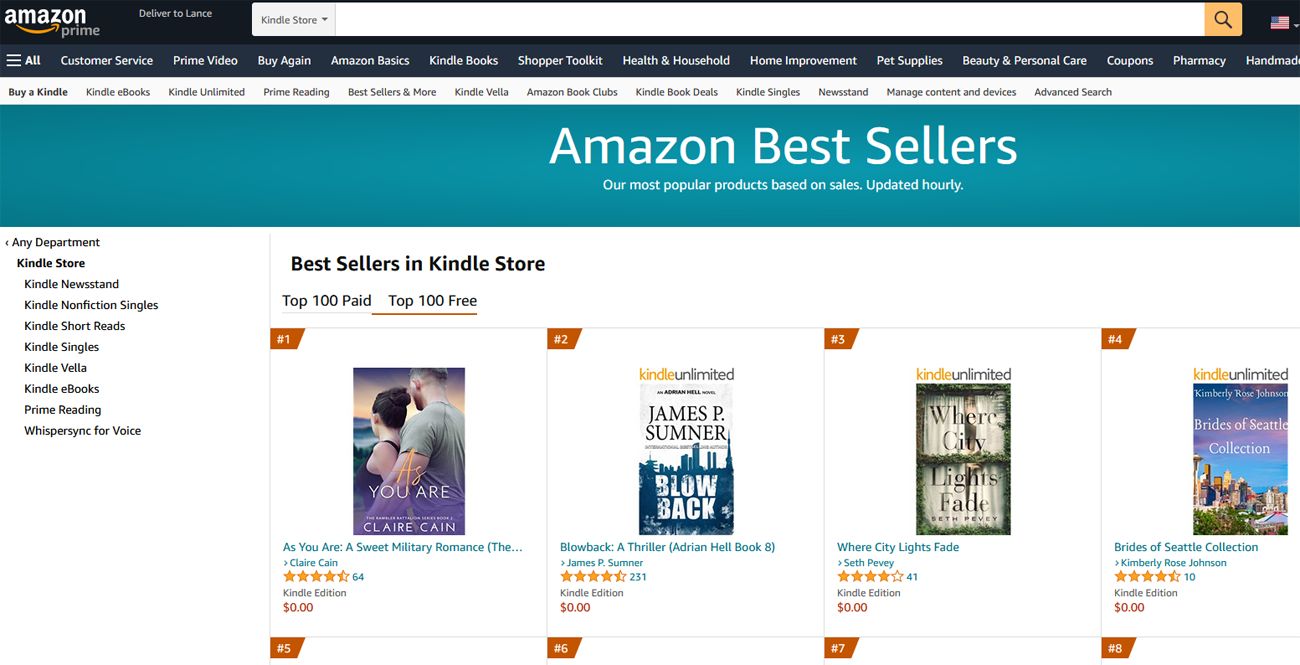Introduction
Creating an eBook for Kindle is a fantastic way to share your knowledge, stories, or ideas with a global audience. With millions of readers using Kindle devices or apps, self-publishing an eBook can open up a world of opportunities for aspiring authors and content creators.
In this comprehensive guide, we will walk you through the step-by-step process of creating an eBook for Kindle. From choosing a topic and conducting research, to writing, editing, formatting, and publishing, we will cover all the essential aspects to make your eBook stand out.
Before we dive into the details, it’s important to emphasize that writing an eBook requires dedication, creativity, and a commitment to delivering valuable content. While the process may seem overwhelming at first, with the right approach and mindset, you can successfully create an eBook that resonates with readers.
Whether you’re a seasoned writer or new to the world of self-publishing, this guide will provide you with the knowledge and tools necessary to bring your eBook to life. So, let’s get started on this exciting journey of creating an eBook for Kindle!
Choosing a Topic for Your eBook
Before you start creating your eBook, it’s important to choose a topic that not only resonates with you, but also has the potential to attract a wide audience. A well-chosen topic can make a significant difference in the success of your eBook.
To begin, consider your own passions, expertise, and interests. What knowledge or experience do you possess that you can share with others? Remember, writing about a topic you’re passionate about will not only make the process more enjoyable, but it will also shine through in your writing, captivating your readers.
Next, conduct market research to identify popular trends and topics within your niche. Look for gaps or underserved areas where your eBook can provide unique value. This research can be done through keyword analysis, reading customer reviews of similar eBooks, or engaging with your target audience through surveys or online forums.
Additionally, consider the target audience for your eBook. Who are you writing for? Understanding the demographics, interests, and needs of your potential readers can help you narrow down and refine your topic. It’s important to strike a balance between choosing a topic you’re passionate about and one that has a viable market.
Another factor to consider is the evergreen nature of your topic. While trends and fads may come and go, choosing a topic that has timeless appeal will ensure the longevity of your eBook. This doesn’t mean you can’t write about current topics, but consider how you can present the information in a way that will remain relevant in the future.
Lastly, keep in mind that your chosen topic should provide room for you to share valuable insights, tips, or stories. Your eBook should add value to the reader’s life and leave them feeling satisfied with their investment of time and money.
By carefully considering these factors, you can confidently choose a topic that aligns with your passion, has market potential, speaks to your target audience, and offers timeless value. This will lay the foundation for a successful eBook that will resonate with readers.
Researching and Outlining Your eBook
Once you’ve chosen a topic for your eBook, the next step is to conduct thorough research and create a solid outline. Researching and outlining will provide a framework for your eBook, ensuring that you cover all the necessary information and deliver a well-organized and engaging final product.
Begin by immersing yourself in the subject matter. Read books, articles, and journals related to your topic, and take notes on key points, interesting facts, and supporting evidence. Use reputable sources to ensure the accuracy and credibility of the information you include in your eBook.
As you gather information, start organizing it into categories or chapters. This will help you create a logical flow and structure for your eBook. Consider the most important concepts or ideas you want to convey and how they can be presented in a way that is easy for readers to follow.
Next, refine your outline by breaking down each chapter or section into subtopics. This will allow you to delve deeper into specific aspects of your topic and provide a comprehensive and well-rounded exploration. Consider the questions your readers might have and address them within the outline.
Furthermore, think about the overall tone and voice of your eBook. Are you aiming for a conversational style, or do you prefer a more formal or academic approach? Defining the tone will guide your writing and help create a consistent and engaging reading experience.
Remember to keep your target audience in mind throughout the research and outlining process. What kind of information would they find valuable? What are their pain points or challenges that your eBook can address? Tailor your content and focus on solving their problems or fulfilling their needs.
Lastly, be open to adjusting your outline as you dive deeper into the research. New ideas or insights may emerge, and it’s important to be flexible and responsive to ensure your eBook remains relevant and captivating.
By conducting thorough research and creating a detailed outline, you will lay the groundwork for a well-structured and informative eBook. This preparation will not only make the writing process smoother but also ensure that your final product meets the needs and expectations of your readers.
Writing Your eBook
With a well-researched outline in hand, it’s time to start writing your eBook. The writing process may seem daunting, but with proper planning and a disciplined approach, you can create a compelling and engaging piece of content that captivates your readers.
Begin by setting aside dedicated time for writing. Create a schedule that works for you and commit to it. Consistency is key in maintaining your momentum and ensuring progress.
Start each writing session by reviewing your outline and refreshing your memory on the main points and subtopics you plan to cover. This will help you maintain focus and stay on track as you write.
When it comes to the actual writing, adopt a conversational yet authoritative tone. Write as if you are having a conversation with your readers, providing them with valuable insights and information in a manner that is easy to understand.
Focus on clarity and simplicity, avoiding jargon or complex terminology that may alienate your readers. Be concise and to the point, conveying your ideas and concepts in a straightforward manner. Utilize storytelling techniques, examples, and anecdotes to make your content relatable and memorable.
As you write, be mindful of the flow and structure of your eBook. Each chapter or section should seamlessly transition into the next, creating a cohesive narrative that keeps readers engaged from start to finish. Use subheadings, bullet points, and numbered lists to break up the text and enhance readability.
Remember that your eBook should provide value and actionable information. Support your claims and statements with reliable sources, statistics, and studies whenever possible. This not only adds credibility to your writing but also allows readers to delve deeper into the subject matter if they desire.
Lastly, embrace the editing process. Once you have completed the initial draft of your eBook, take the time to review and revise it. Look for areas where the content can be refined, strengthened, or further expanded. Ensure that your writing is free from grammatical errors, typos, and inconsistencies.
By following these tips and being intentional in your writing, you can create a well-crafted eBook that resonates with your readers. Remember to stay true to your unique voice and purpose, and don’t be afraid to let your creativity shine through in your writing.
Editing and Proofreading Your eBook
Editing and proofreading are crucial steps in the eBook creation process. They ensure that your content is polished, error-free, and ready to be enjoyed by your readers. Taking the time to carefully review and refine your eBook will elevate the overall quality and professionalism of your work.
First, start with a comprehensive read-through of your eBook to identify any glaring issues or areas that need improvement. Look for inconsistencies in style, tone, or formatting. Pay attention to sentence structure, grammar, and spelling errors. Make note of any sections that may require further clarification or revision.
After your initial read-through, it’s helpful to take a break and come back to your eBook with fresh eyes. Often, when we’ve been immersed in writing, it’s easy to overlook small mistakes or awkward phrasing. Give yourself some distance before moving onto the next stage of editing.
Next, focus on the content itself. Assess the clarity and effectiveness of your writing. Are your main ideas presented coherently? Are there any redundancies or tangents that can be eliminated? Trim down unnecessary information and ensure that each sentence and paragraph contributes directly to the overall message of your eBook.
When it comes to correcting errors, rely on both manual proofreading and digital tools. Use a grammar and spell-check software to catch obvious mistakes, but also read through your eBook carefully to catch any errors that the software might miss. Pay attention to punctuation, verb tense consistency, and word usage.
Consider enlisting the help of beta readers or professional editors to provide feedback and catch any issues you may have overlooked. Having a fresh pair of eyes can provide valuable insights and help you polish your eBook to perfection.
Lastly, perform a final read-through to ensure that your eBook flows smoothly and is ready for publishing. Pay attention to formatting, visual elements, and overall aesthetics of your eBook. Ensure that your headers, subheadings, and text formatting are consistent throughout.
By taking the time to edit and proofread your eBook, you can present a final product that is free from errors and showcases your professionalism as an author. This attention to detail will make a significant difference in the reader’s experience and elevate the overall quality of your eBook.
Formatting Your eBook for Kindle
Proper formatting is essential to ensure that your eBook is visually appealing and easy to read on Kindle devices and apps. Kindle formatting requirements differ from traditional print formatting, so it’s important to familiarize yourself with the specific guidelines to optimize the reading experience for your audience.
The first step in formatting your eBook is preparing your manuscript. Convert it to a compatible file format like HTML or EPUB, which can then be easily converted into the Kindle format. Ensure that your text is free from unnecessary formatting such as excessive bold or italics, as it can disrupt the flow of the eBook when converted.
Once you have the manuscript ready, consider the layout and design elements. Kindle allows for adjustable font sizes, so select a simple and legible font that offers good readability across various devices. Stick to standard font styles, such as Arial or Times New Roman, to avoid compatibility issues.
Use proper formatting for your header, subheadings, and body text. Utilize HTML formatting tags, such as
for subheadings and
for paragraphs, to structure your content. This helps organize your eBook and enhances the reading experience.
Include a clickable table of contents to allow readers to easily navigate through your eBook. This can be done by creating anchor links within your eBook and linking them to the corresponding chapters or sections. Make sure the table of contents is accessible from the beginning and is properly formatted.
Consider the use of images and graphics to enhance your eBook. Ensure that images are properly sized and aligned, and that their resolutions are optimized for digital viewing. Use JPEG or PNG file formats and maintain a balance between image quality and file size to avoid slowing down the reading experience.
When it comes to adding hyperlinks, use them judiciously and make sure they are relevant and functional. Test all links before publishing your eBook to ensure they navigate to the intended destinations. Avoid excessively long URLs, as they can be cumbersome for readers to navigate on smaller digital screens.
Don’t forget to create a professional and eye-catching cover for your eBook. Kindle recommends a cover size of 1600 pixels on the longest side for best results. Ensure that your cover image accurately represents the content and theme of your eBook while grabbing the reader’s attention.
Finally, before publishing, test your eBook on different Kindle devices and apps to make sure the formatting remains consistent and visually appealing. Pay attention to issues like text alignment, line spacing, and font size adjustments, and make necessary adjustments as needed.
By adhering to Kindle’s formatting guidelines and optimizing your eBook’s layout and design, you’ll provide readers with a visually pleasing and user-friendly experience. Proper formatting contributes to the overall professionalism and appeal of your eBook, increasing the chances of attracting and retaining readers.
Creating a Cover for Your eBook
The saying “don’t judge a book by its cover” may hold true in some situations, but when it comes to eBooks, a captivating cover plays a crucial role in attracting potential readers. The cover is the first impression readers have of your eBook, so it’s important to create a visually appealing and professional design that reflects the content and grabs readers’ attention.
When designing your eBook cover, consider the genre and target audience. The cover should align with the expectations and preferences of your specific readership. Research bestselling eBooks in your genre to get a sense of the design elements that resonate with your target audience.
One of the most important aspects of a successful eBook cover is a high-quality image or illustration. Invest in a visually striking image that accurately represents the essence of your eBook. If you have design skills, you can create a custom cover using graphic design software, or you can hire a professional designer to bring your vision to life.
Choose colors and fonts that evoke the mood and tone of your eBook. Select fonts that are legible and visually appealing, ensuring that they complement the overall design. Consider using bold or eye-catching typography for your eBook title and subtitle to make them stand out.
Keep the design simple and uncluttered. Avoid overcrowding the cover with too much information or imagery. It’s essential to strike a balance between an eye-catching design and a clean, uncluttered look. Remember, the cover design should entice readers, not overwhelm them.
Include the necessary text elements on your cover, such as the eBook title, author name, and subtitle if applicable. Make sure the text is easily readable and doesn’t blend into the background image. Consider the size and placement of your text to ensure it stands out and is legible, even in thumbnail size.
Test your cover design by resizing it to a smaller scale, such as a thumbnail, to see how it will appear in online bookstores or promotional materials. Ensure that the design remains clear and inviting, even in smaller sizes.
Lastly, create multiple versions of your cover and gather feedback from others, such as friends, colleagues, or potential readers. Their input can help you identify any areas for improvement and ensure that your cover design resonates with your intended audience.
Remember, a well-designed eBook cover is your opportunity to make a strong first impression and entice readers to click on your eBook. By investing time and effort into creating an appealing and professional cover, you increase the likelihood of attracting potential readers and making your eBook stand out in a crowded marketplace.
Publishing Your eBook on Kindle Direct Publishing
Once you have completed the writing, editing, and formatting of your eBook, it’s time to publish it on Kindle Direct Publishing (KDP), Amazon’s self-publishing platform. KDP allows you to reach millions of potential readers worldwide and provides a straightforward process for getting your eBook into the hands of readers.
First, create an account on KDP if you haven’t already done so. Sign in and locate the “Create a new Kindle eBook” option. This will guide you through the steps required to upload your eBook.
Start by providing the necessary details for your eBook, such as the title, subtitle, and author name. You will also need to write a compelling description that entices potential readers to click on your eBook and learn more.
Next, upload the eBook file you prepared during the formatting stage. KDP supports various formats, including MOBI, HTML, and EPUB. Ensure that your eBook is error-free and thoroughly proofread before uploading to provide readers with the best reading experience possible.
Set the pricing and royalties for your eBook. Consider factors such as the length of your eBook, genre, competition, and desired profit margins. KDP offers options for both exclusive and non-exclusive publishing, so evaluate the benefits and restrictions of each before making your decision.
Choose the territories and rights for your eBook, determining where it will be available for purchase and which rights you want to retain. With KDP, you have control over your publishing options, allowing you to reach readers globally while maintaining ownership of your work.
Design a visually appealing eBook cover that meets KDP’s guidelines. Ensure that the dimensions and file format align with the platform’s requirements for optimal display on various Kindle devices and apps.
Once all the details are in place, review your eBook’s information and preview it using KDP’s built-in tools. Make sure everything looks as intended and that there are no formatting or layout issues.
Finally, click the “Publish Your Kindle eBook” button to officially release your eBook on the Kindle platform. Depending on your selected publishing options, KDP will make your eBook available for purchase immediately or within 24 to 48 hours.
After publishing, monitor your eBook’s performance using the sales reports provided by KDP. Utilize KDP’s marketing and promotion tools to enhance the visibility of your eBook and attract readers. Consider running Kindle promotions, participating in Kindle Unlimited, or seeking reviews from trusted sources to further maximize your book’s exposure.
Publishing your eBook on KDP opens the doors to a vast audience of readers. With careful attention to detail and effective marketing strategies, you can empower your eBook to reach new heights and connect with readers around the globe.
Marketing and Promoting Your eBook
Once you have published your eBook on Kindle, it’s time to focus on marketing and promotion to increase its visibility and attract readers. While Kindle’s vast reach provides exposure, implementing effective marketing strategies can significantly enhance the discoverability and success of your eBook.
First, leverage the power of online platforms, such as social media, to create awareness about your eBook. Establish a robust author platform by creating dedicated social media profiles and engaging with your target audience. Share snippets, behind-the-scenes content, and updates about your eBook’s progress to generate curiosity and build anticipation.
Utilize your website or blog to showcase your eBook. Create an enticing landing page with a detailed description, appealing graphics, and a call-to-action to encourage visitors to purchase your eBook. Consider offering a sample chapter or a limited-time promotional discount to incentivize readers.
Encourage reviews from your readers by reaching out to your network, offering free copies in exchange for honest feedback, or utilizing Amazon’s “Ask the Author” feature. Positive reviews play an essential role in attracting potential readers and building credibility for your eBook.
Consider running promotional campaigns and discounts to generate buzz around your eBook. Take advantage of Kindle’s promotional tools, such as Kindle Countdown Deals and Free Book Promotions, to capture the attention of bargain-seeking readers and boost sales during specific periods.
Explore the opportunity of participating in Kindle Unlimited (KU). Enrollment in KU allows subscribers to read your eBook for free, increasing both exposure and potential returns through the Kindle Unlimited Royalty program. Ensure that your eBook is enrolled in KDP Select to take advantage of this program.
Collaborate with other authors in your genre to cross-promote each other’s eBooks. This could include featuring guest posts on each other’s blogs, appearing in joint interviews or podcasts, or even bundling your eBooks together for a limited-time promotion. By leveraging each other’s audiences, you can broaden your reach and gain new readers.
Explore advertising options available on platforms like Amazon Advertising or other relevant websites and blogs. Utilize targeted keywords and demographics to reach your ideal readers. Track the performance of your ads and adjust your campaigns accordingly to optimize your return on investment.
Engage in offline promotional strategies as well. Attend local book fairs, speaking engagements, or workshops related to your eBook’s topic. Distribute business cards or promotional materials with links to your eBook to interested attendees. Building connections in the offline world can lead to valuable opportunities for exposure.
Lastly, invest in continuous self-promotion as an author. Develop your personal brand and establish yourself as an authority in your niche through consistent content creation, guest blogging, podcast appearances, or speaking engagements. A strong personal brand not only enhances your eBook’s visibility but also cultivates a loyal fan base.
Implementing effective marketing and promotion strategies is critical to ensuring the success of your eBook. By leveraging online and offline channels, collaborating with others in your industry, and continuously promoting your work, you can increase your eBook’s visibility, attract new readers, and foster long-term success as an author.
Tracking and Analyzing Your eBook’s Performance
Tracking and analyzing the performance of your eBook is essential for understanding its success and making informed decisions to enhance its reach and engagement. By monitoring key metrics and analyzing data, you can gain valuable insights into your eBook’s performance and make necessary adjustments to optimize its potential.
Start by utilizing the reporting and analytics tools provided by Kindle Direct Publishing (KDP). KDP offers detailed sales reports that allow you to track the number of copies sold, royalties earned, and reader engagement. Monitor these metrics regularly to assess your eBook’s performance over time.
Keep a close eye on customer reviews and ratings. Positive reviews indicate reader satisfaction, while negative reviews can provide valuable feedback and insights into areas that may require improvement. Address reviewer feedback constructively and consider it as an opportunity to enhance your eBook.
Take advantage of Amazon’s Author Central. Author Central allows you to access additional sales data, such as author ranking and bestseller rankings within specific categories or subcategories. By monitoring these rankings, you can gauge your eBook’s relative performance compared to similar books in your genre.
Use website analytics to track visitors to your eBook’s landing page. Tools like Google Analytics provide valuable data on visitor demographics, traffic sources, and user behavior. Analyzing this data can help you understand which marketing channels are most effective in driving traffic and converting visitors into readers.
Measure the conversion rates of your promotional campaigns. If you run ads or promotional discounts, track the click-through rates and subsequent sales to determine the effectiveness of your marketing efforts. This data can guide future marketing decisions and budget allocation.
Engage with readers and build a community around your eBook. Pay attention to reader feedback, comments, and engagement on social media platforms, your blog, or online forums. Actively respond to reader inquiries and foster a personal connection. By cultivating a loyal fanbase, you create a strong foundation for future success.
Consider conducting surveys or polls to gather readers’ opinions and preferences. This can provide valuable insights into what resonates with your audience and help guide your future content creation and marketing strategies.
Continuously evaluate and adjust your marketing and promotion tactics based on the data and feedback you collect. Experiment with different approaches and assess their impact on sales, reader engagement, and overall eBook performance. Identifying trends and patterns will enable you to refine your strategies and target your efforts more effectively.
Tracking and analyzing your eBook’s performance is an ongoing process. Regularly review your data and metrics, and use the insights gained to improve your eBook’s visibility, engage with your audience, and refine your marketing strategies. With a data-driven approach, you can take your eBook to new heights of success.
Conclusion
Congratulations on reaching the end of this guide on creating, publishing, and promoting your eBook for Kindle! We’ve covered the essential steps and strategies to help you successfully navigate the self-publishing process.
Remember, creating an eBook requires passion, dedication, and a commitment to delivering valuable content to your readers. From choosing a topic to researching, writing, editing, formatting, and marketing, each step plays a crucial role in ensuring the success of your eBook.
By selecting a compelling topic and conducting thorough research, you lay the foundation for a valuable and engaging eBook. Crafting well-written content and paying attention to formatting ensure an enjoyable reading experience for your audience. Publishing your eBook on Kindle Direct Publishing opens up opportunities for global reach and readership.
Furthermore, marketing and promoting your eBook are essential to boosting its visibility and attracting readers. By utilizing online and offline strategies, engaging with your target audience, and continuously promoting your work, you can expand your readership and build a loyal fan base.
As an author, tracking and analyzing the performance of your eBook will help you make data-driven decisions to optimize its reach and engagement. By monitoring sales, reviews, and analytics, you can continuously refine your marketing strategies and enhance your eBook’s success.
Throughout this journey, remember to stay true to your unique voice and style. Embrace your creativity and let it shine through in your writing. The quality of your eBook, coupled with effective marketing and promotion, will set you on the path to becoming a successful self-published author.
Now it’s time for you to put these strategies into action. Take the knowledge you’ve gained and apply it to your own eBook project. Embrace the challenges and enjoy the process of creating something that will resonate with readers around the world.
Best of luck on your journey as an eBook author, and may your eBook thrive and leave a lasting impact on your readers!

























